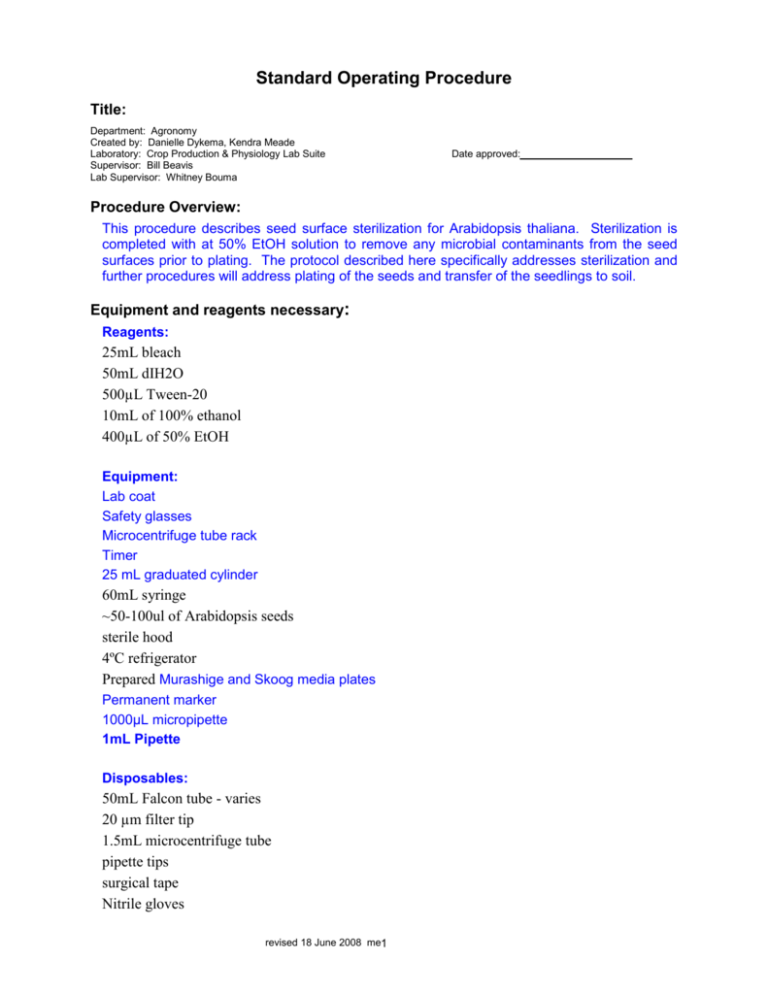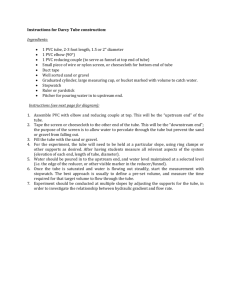Arapbidopsis - seed sterilization
advertisement

Standard Operating Procedure Title: Department: Agronomy Created by: Danielle Dykema, Kendra Meade Laboratory: Crop Production & Physiology Lab Suite Supervisor: Bill Beavis Lab Supervisor: Whitney Bouma Date approved: Procedure Overview: This procedure describes seed surface sterilization for Arabidopsis thaliana. Sterilization is completed with at 50% EtOH solution to remove any microbial contaminants from the seed surfaces prior to plating. The protocol described here specifically addresses sterilization and further procedures will address plating of the seeds and transfer of the seedlings to soil. Equipment and reagents necessary: Reagents: 25mL bleach 50mL dIH2O 500µL Tween-20 10mL of 100% ethanol 400µL of 50% EtOH Equipment: Lab coat Safety glasses Microcentrifuge tube rack Timer 25 mL graduated cylinder 60mL syringe ~50-100ul of Arabidopsis seeds sterile hood 4ºC refrigerator Prepared Murashige and Skoog media plates Permanent marker 1000µL micropipette 1mL Pipette Disposables: 50mL Falcon tube - varies 20 µm filter tip 1.5mL microcentrifuge tube pipette tips surgical tape Nitrile gloves revised 18 June 2008 me1 Kemwipes Procedure: For Seed Sterilization solutions: 1. Turn on laminar flow hood four hours before use and wipe down with 75% EtOH solution from media mixing and pouring 2. Sterilize equipment: clean pipette, tip box, tube rack, marker, timer, and gloves with 75% EtOH solution 3. Label a 50mL Falcon tube “Seed Sterilization Solution” with a permanent marker 4. To the Falcon tube, add 25mL bleach, 25mL dIH2O and 500µL Tween-20 and mix tube gently. 5. In the sterile hood, pour solution into a 60mL syringe with a 20 µm filter tip attached to it; filter the solution into a new 50mL Falcon tube. 6. Label a second 50mL Falcon tube “50% Ethanol Solution” and add 10mL of 100% ethanol and 10mL of sterile dIH2O using the 25mL graduated cylinder to the tube and mix gently. Seed Sterilization process: 1. In a 1.5mL microcentrifuge tube, measure out desired amount of Arabidopsis seeds. 2. In a sterile hood, add 400µL of prepared 50% EtOH solution to tube using a 1mL pipette, close and invert tube gently for 1 minute. 3. Remove solution from tube using a new pipette tip. 4. Add 400µL of Seed Sterilization to tube, close and invert tube gently for 10 minutes* 5. Remove solution from tube using a new pipette tip. 6. Rinse tube 3x with 400µL of sterile dIH2O, inverting tube gently 1 minute for each rinse, remove solution from tube using a new pipette tip. 7. After 3rd rinse, take ~100µL of seed/dIH2O mixture and plate 10-15 seeds per plate. 8. Seal plate with surgical tape and place right side up in 4oC for 4 days and then place in growth chamber. *During the 10 minutes, remove plates from 4oC and place in hood to help reduce condensation on plates Personal Protective Equipment / Engineering Controls: Lab coat, eye protection and hand protection must be selected as required by Section D of the EH&S Laboratory Safety Manual. Check the box(es) next to the item(s) which are appropriate for your procedure. Nitrile gloves Safety glasses Face shield Dust mask Latex gloves Splash goggles Lab coat Fume hood Neoprene gloves Vented goggles Apron Biosafety cabinet Insulated gloves Eye wash station Safety shower Respirator Note: Open-toed and heeled shoes are NOT allowed. Other Control Measures: revised 18 June 2008 me2 Handling & Storage Precautions: Handling: Avoid breathing dust, mist, or vapor. Keep container tightly closed. Avoid contact with clothing and other combustible materials. Avoid ingestion and inhalation. Use with adequate ventilation. Use only in a chemical fume hood. Discard contaminated shoes. Storage: Store in a tightly closed container. Keep refrigerated. (Store below 4�C/39�F.) Waste Disposal Procedures: Dispose of in a manner consistent with federal, state, and local regulations. Spill/Release Containment and Clean Up/Decontamination Procedures: Absorb spill with inert material (e.g. vermiculite, sand or earth), then place in suitable container. Clean up spills immediately, observing precautions in the Protective Equipment section. Provide ventilation. Health & Safety Summary for Required Reagents: Brief description of associated hazards C a r c i n o g e n T e r a t o g e n Chemical name Sodium hypochlorite Tween-20 Ethanol M u t a g e n R e p r o d u c t i v e E f f e c t s S e n s i t i z e r I r r i t a n t T o x i c C o r r o s i v e C o m b u s t i b l e C o m p r e s s e d G a s E x p l o s i v e F l a m m a b l e O r g a n i c P e r o x i d e s O x i d i z e r Target Organ(s) x x x x x H i g h l y T o x i c x Eyes, skin. P y r o p h o r i c U n s t a b l e W a t e r H e a l t h R e a c t i v e F l a m m a b i l i t y R e a c t i v i t y Incompatibilities x Eyes, skin Eyes, Skin, Reproductive System, Central nervous system (CNS), Liver, Kidney, Blood x x Metals, oxidizing agents, reducing agents, strong acids, acids (organic, e.g. acetic acid, benzoic acid, formic acid, methanoic acid, oxalic acid), methanol, ammonium salts 2 0 0 Strong oxidizing agents, Strong acids, Acid anhydrides, Acid chlorides 2 3 0 The above summary consists of guidelines for proper handling & disposal of chemicals used in this procedure. You must read and understand the contents of the entire MSDS(s) before starting this procedure. References: List references used in preparing this procedure. revised 18 June 2008 me3








